Physical Address
304 North Cardinal St.
Dorchester Center, MA 02124
Physical Address
304 North Cardinal St.
Dorchester Center, MA 02124
Plywood is a popular material for shelving. You may have come here to figure out why, or simply to learn more about the thickness of plywood is used in general. Then “How thick of plywood for shelves” is the article for you.
Plywood is made up of layers of solid wood that are glued together. The most appealing layers are applied to the outer layers (called veneer). Exotic wood species (which are also more expensive) can be used to produce a product that is both visually attractive and unique. Each layer of plywood has a grain that runs at a 90° angle to the one above or below it. This gives the finished product a surprising amount of strength for its thickness. It also reduces overall movement, allowing it to remain straight for a longer period of time. In construction projects, plywood can be painted, stained, drilled, glued, and otherwise treated like real wood.
Plywood, in my opinion, is the best material for shelving. The smooth feel and look are appealing, and when properly maintained, it maintains a straight line over a long span and can carry more weight than a solid wood board of the same size. Plywood also needs less effort to create larger or deeper boards due to the way it is marketed, making it far less expensive to utilize in construction when both labor and time are included in.

Plywood is often offered in 48-foot-long sheets of various thicknesses. 1/4, 1/2, and 3/4 inch sizes or near equivalents (3/8′′, 15/32′′ or 12mm, 23/32′′ or 18mm) are the most frequent. The thicknesses are the same, but the overall diameters are smaller. Typically 24′ or 28′, however certain variations are also available in 44′. If you simply need a modest amount, are concerned about transporting a large piece in a smaller vehicle, or want to employ a more exotic or pricey wood species, these solutions are suitable.
Obviously, you must choose the optimal thickness after calculating the required cuts for your project. You’ll need the following basic facts (it’s okay if it’s not accurate) to figure it out:

How often will shelves require support before they begin to sag? If you don’t know or understand what I’m talking about, there’s a great online tool called the Sagulator that I use all the time. As a general rule, the thicker the suggested product must be, the heavier the things you will be placing on the shelves. The most common thickness used in shelves is 3/4 inch. Cabinetry, furniture, and smaller ornamental projects may all benefit from a mix of 1/2 and 3/4 inch, with the occasional 1/4 inch thrown in for good measure.

If you’re doing 24″ wide shelving or have very big loads headed for these shelves, you might want to move up to 5/8″ or 3/4″ plywood.
First and foremost, the type of wood you pick to construct your bookshelves will have an influence on both the design and the cost of your project. Because it is robust yet inexpensive—especially when compared to other solid woods—34-inch plywood is considered the industry standard.
44mm is the optimal thickness for shelves since it is robust and has a significant appearance. If you want a shelf with a minimum thickness of 32mm, plane it down to that thickness. Anything less would, however, render the shelf too fragile and, as a result, unstable.
Plywood for the shelf should be at least 1 inch thick and 5 inches deep.
The most common thickness used in shelves is 3/4 inch. Cabinetry, furniture, and smaller ornamental items may employ a mix of 1/2 and 3/4 inch and, on rare occasions, 1/4 inch.
Plywood for shelves should be at least 1/2 inch thick. However, 3/4′′ is preferable for thicker shelves that can support greater weight without bending.
As long as you don’t make it too long, you may use nominal one-inch pine planks or 1/2 inch plywood for pantry shelves. Because canned items can be rather heavy, pantry shelves must be pretty sturdy.
My objective with this essay-how thick of plywood for shelves is to encourage you to utilize plywood without fear for shelves. Plywood is a more cost-effective, ecologically responsible, and long-lasting alternative to wood boards, with the same ease of use and a wide range of finish possibilities.